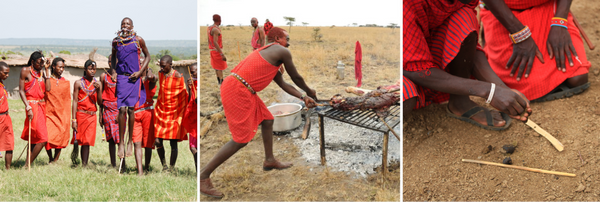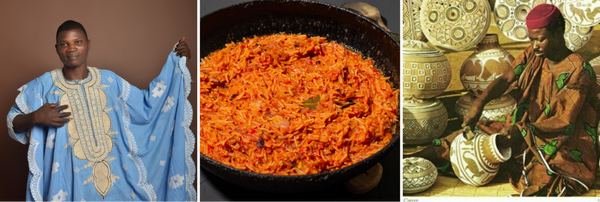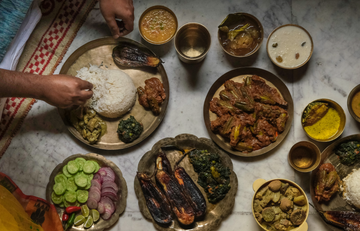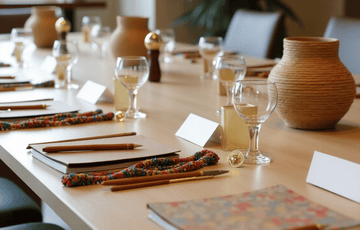The world of African cuisine offers a delightful journey through diverse flavors and traditions, from the bustling markets of West Africa to the savannahs of East Africa. Each region has its own special culinary delights that leave taste buds craving for more. This culinary adventure is beautifully complemented by the artistry of traditional African cutlery, where each piece becomes a work of art reflecting the cultural heritage of its people.
The Berbers of North Africa:
The Berber are a north African community mainly found in the regions of Morocco, Algeria, Tunisia, Libya, Egypt, Mali, Niger, and Mauritania. This community boasts of diverse culinary styles that reflect its rich history and vibrant culture. In Moroccan markets, for example, open air markets are filled with fragrant spices. Here, you'll find the iconic dish, couscous, gracing many plates. This light and fluffy semolina-based dish is often accompanied by flavorful stews cooked to perfection in iconic clay tagines.
Their skilled artisans carve wooden spoons, infusing them with amazing designs that depict their folklore, religious symbols, and daily life scenes. These talented craftsmen use traditional tools, such as chisels and knives, to carefully shape the wood into functional and visually stunning masterpieces. The final product is not only a functional eating utensil but also a piece of art that serves as a tangible link to their cultural heritage.

A Berber Man,Display of various spices,Couscous rice
The Maasai of East Africa
The Maasai, an indigenous ethnic group residing in the regions of Kenya and Tanzania, cherish a rich culinary heritage centered around their deep connection to their land and cattle. Their diet revolves around milk, blood, and meat, with roasting the meat over an open fire to infuse it with a smoky flavor that is both irresistible and communal. Alongside their culinary expertise, the Maasai are skilled in crafting traditional bone knives from animal bones, symbolizing their profound reverence for their cattle and land. This practice, passed down through generations, embodies their cultural identity and resourcefulness, ensuring the preservation of their ancient traditions for future generations.
The Maasai's unique culinary practices and artful crafting of bone knives reflect a profound connection with nature, a strong sense of community, and a remarkable resilience in adapting to their environment. As guardians of their culinary and cultural heritage, the Maasai continue to thrive, passing down their ancient wisdom to ensure the continuity of their distinctive way of life for years to come. Their culinary journey is a testament to their deep-rooted cultural identity and a celebration of their strong bond with their ancestral land and cattle.

Maasai men,A maasai roasting meat,Carving wooden cutlery
Source:seeafricatoday.com
The Yoruba of West Africa:
The Yoruba people are an ethnic group mainly residing in Nigeria, as well as some regions of Benin and Togo.Yoruba cuisine is characterized by its bold and flavorful dishes that showcase the region's abundant agricultural resources. The use of a variety of aromatic spices, such as cayenne pepper, ginger, and cloves, creates an explosion of taste in their meals. One of the crowning jewels of Yoruba cuisine is undoubtedly Jollof rice, a beloved one-pot wonder known for its colorful appearance and savory taste. Prepared with rice, tomatoes, onions, and an array of spices, Jollof rice is a staple at celebratory gatherings and family feasts, representing the heart of Yoruba hospitality.
Their culture also shines through their artistic craftsmanship, including their cutlery traditions. The Yoruba people take pride in hand-carving wooden forks and crafting calabash bowls that enhance their dining experiences. The calabash, a versatile gourd, serves as the canvas for their artistry. Artisans carve wonderful patterns and designs onto the calabash's surface, transforming it into both a functional and visually appealing bowl. Similarly, the wooden forks, made from durable and sustainable wood, are crafted with care and precision, reflecting the Yoruba's commitment to traditional artisanship. The use of these handcrafted cutlery pieces not only elevates the dining experience but also symbolizes the Yoruba people's deep-rooted connection with nature and their appreciation for their ancestral land.

A Yoruba man,Jollof Rice,An Artisan crafting a calabash
Source:pinterest.com
The San People of Southern Africa:
The San people, also known as the Bushmen, are indigenous hunter-gatherers who predominantly inhabit the southern regions of Africa, including Botswana, Namibia, South Africa, and Angola.
Characterizing their cuisine is a reliance on the natural resources found in their surroundings. As skilled hunter-gatherers, the San people have mastered the art of foraging for wild plants, fruits, nuts, and tubers. They also hunt various game animals, including antelope, birds, and insects, using traditional methods such as bows and poison-tipped arrows.
In addition to their cuisine, the San people's cutlery reflects their adaptability and ingenuity. They utilize materials found in their environment to craft functional tools for their daily needs. For instance, they might fashion knives or cutting tools from sharp stones or pieces of bone .One unique aspect of their cutlery is their use of ostrich eggshells. The San people skillfully hollow out and clean the eggshells to create bowls and containers that serve various purposes, including storing water and food. The San's culinary and cutlery practices embody their profound connection with nature and their ability to sustain themselves by working in harmony with their environment.

San People,A woman drinking from an ostrich eggshell,A san man hunting
Source:africaglobalnews.com,istockphoto.com,shareyouressays.com
In conclusion, the culinary delights of these African communities are as diverse and captivating as their traditional cutlery. From the Berbers' couscous and tagines to the Maasai's smoky roasted meat and the Yoruba's flavorful Jollof rice, each dish reflects a rich history and cultural identity. The appreciation of traditional African cutlery goes beyond the meal; it becomes a form of art that tells stories, preserves cultural heritage, and highlights the resourcefulness of each community's artisans. Embracing African cuisine and its artful cutlery is an invitation to embark on a sensory and cultural journey like no other.





